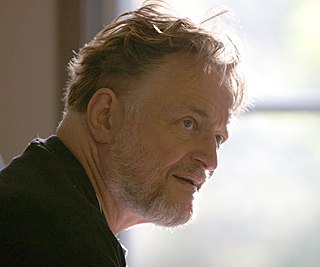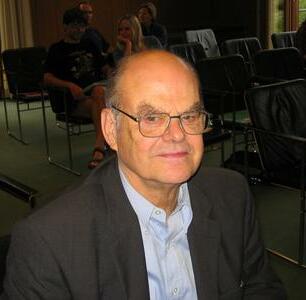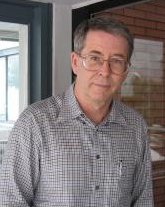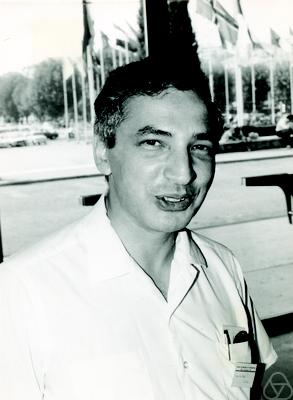Related Research Articles

In mathematics, the classification of finite simple groups is a result of group theory stating that every finite simple group is either cyclic, or alternating, or belongs to a broad infinite class called the groups of Lie type, or else it is one of twenty-six or twenty-seven exceptions, called sporadic. The proof consists of tens of thousands of pages in several hundred journal articles written by about 100 authors, published mostly between 1955 and 2004.

John Horton Conway was an English mathematician active in the theory of finite groups, knot theory, number theory, combinatorial game theory and coding theory. He also made contributions to many branches of recreational mathematics, most notably the invention of the cellular automaton called the Game of Life.

In abstract algebra, a finite group is a group whose underlying set is finite. Finite groups often arise when considering symmetry of mathematical or physical objects, when those objects admit just a finite number of structure-preserving transformations. Important examples of finite groups include cyclic groups and permutation groups.

In mathematics, a sporadic group is one of the 26 exceptional groups found in the classification of finite simple groups.
The year 1983 in science and technology involved many significant events, as listed below.

Richard Dagobert Brauer was a leading German and American mathematician. He worked mainly in abstract algebra, but made important contributions to number theory. He was the founder of modular representation theory.

John Griggs Thompson is an American mathematician at the University of Florida noted for his work in the field of finite groups. He was awarded the Fields Medal in 1970, the Wolf Prize in 1992, and the Abel Prize in 2008.
The Leroy P. Steele Prizes are awarded every year by the American Mathematical Society, for distinguished research work and writing in the field of mathematics. Since 1993, there has been a formal division into three categories.

Daniel E. Gorenstein was an American mathematician. He earned his undergraduate and graduate degrees at Harvard University, where he earned his Ph.D. in 1950 under Oscar Zariski, introducing in his dissertation a duality principle for plane curves that motivated Grothendieck's introduction of Gorenstein rings. He was a major influence on the classification of finite simple groups.

Michael George Aschbacher is an American mathematician best known for his work on finite groups. He was a leading figure in the completion of the classification of finite simple groups in the 1970s and 1980s. It later turned out that the classification was incomplete, because the case of quasithin groups had not been finished. This gap was fixed by Aschbacher and Stephen D. Smith in 2004, in a pair of books comprising about 1300 pages. Aschbacher is currently the Shaler Arthur Hanisch Professor of Mathematics at the California Institute of Technology.

Walter Feit was an Austrian-born American mathematician who worked in finite group theory and representation theory. His contributions provided elementary infrastructure used in algebra, geometry, topology, number theory, and logic. His work helped the development and utilization of sectors like cryptography, chemistry, and physics.
In mathematical finite group theory, the Thompson subgroup of a finite p-group P refers to one of several characteristic subgroups of P. John G. Thompson (1964) originally defined to be the subgroup generated by the abelian subgroups of P of maximal rank. More often the Thompson subgroup is defined to be the subgroup generated by the abelian subgroups of P of maximal order or the subgroup generated by the elementary abelian subgroups of P of maximal rank. In general these three subgroups can be different, though they are all called the Thompson subgroup and denoted by .
In mathematics, a quasithin group is a finite simple group that resembles a group of Lie type of rank at most 2 over a field of characteristic 2. More precisely it is a finite simple group of characteristic 2 type and width 2. Here characteristic 2 type means that its centralizers of involutions resemble those of groups of Lie type over fields of characteristic 2, and the width is roughly the maximal rank of an abelian group of odd order normalizing a non-trivial 2-subgroup of G. When G is a group of Lie type of characteristic 2 type, the width is usually the rank.

Jonathan Lazare Alperin is an American mathematician specializing in the area of algebra known as group theory. He is notable for his work in group theory which has been cited over 500 times according to the Mathematical Reviews. The Alperin–Brauer–Gorenstein theorem is named after him.
In abstract algebra, the focal subgroup theorem describes the fusion of elements in a Sylow subgroup of a finite group. The focal subgroup theorem was introduced in and is the "first major application of the transfer" according to. The focal subgroup theorem relates the ideas of transfer and fusion such as described by Otto Grün in. Various applications of these ideas include local criteria for p-nilpotence and various non-simplicity criteria focussing on showing that a finite group has a normal subgroup of index p.
In group theory, Bender's method is a method introduced by Bender (1970) for simplifying the local group theoretic analysis of the odd order theorem. Shortly afterwards he used it to simplify the Walter theorem on groups with abelian Sylow 2-subgroups Bender (1970b), and Gorenstein and Walter's classification of groups with dihedral Sylow 2-subgroups. Bender's method involves studying a maximal subgroup M containing the centralizer of an involution, and its generalized Fitting subgroup F*(M).
In finite group theory, a branch of mathematics, a group is said to be of characteristic 2 type or even type or of even characteristic if it resembles a group of Lie type over a field of characteristic 2.
Koichiro Harada is a Japanese mathematician working on finite group theory.
Richard Neil Lyons is an American mathematician, specializing in finite group theory.
The Levi L. Conant Prize is a mathematics prize of the American Mathematical Society, which has been awarded since 2001 for outstanding expository papers published in the Bulletin of the American Mathematical Society or the Notices of the American Mathematical Society in the past five years. The award is worth $1,000 and is awarded annually.
References
- ↑ Mathematicians who classified finite groups Archived 2011-09-24 at the Wayback Machine